In the heart of the American Southwest, where time seems etched into the towering red rock walls, a hidden treasure awaits those who dare to look up. Welcome to the Grand Canyon, a place of awe-inspiring natural beauty by day and a theater of cosmic wonder by night. As the sun dips below the canyon’s rim, a remarkable transformation occurs, revealing a realm of sparkling stars, celestial wonders, and mysteries of the universe that have captivated humanity for millennia.
I invite you on a journey beyond the well-trodden trails and iconic vistas. Here, under the vast expanse of the Grand Canyon’s dark skies, you’ll embark on an odyssey that transcends the boundaries of time and space.
In this article, you get to:
Experience Pristine Stargazing: Explore the Grand Canyon’s unparalleled allure for stargazing, catering to both novices and the expert astronomer.
Prime Stargazing Locations: Discover the best stargazing locales within the Grand Canyon National Park, known for its dark and pristine night skies.
Celestial Wonders: Learn about celestial wonders such as constellations, meteor showers, and the breathtaking spectacle of the Milky Way that grace the Grand Canyon’s night sky.
Astrophotography Techniques: Gain insights into astrophotography, from beginners’ basics to advanced techniques for capturing the beauty of the night sky.
Dark Sky Preservation: Explore the park’s dedication to dark sky preservation, its International Dark Sky Park status since 2019, and efforts to combat light pollution.
Notable Night Sky Features: Discover what to expect from the Grand Canyon’s night skies, including the Milky Way, prominent planets, lunar phases, constellations, and meteor showers.
Understanding Natural Nightscapes: Understand the concept of natural nightscapes and their ecological and cultural significance.
Impact of Light Pollution: Learn about the detrimental effects of light pollution on nightscapes, human health, wildlife, ecosystems, and more.
Preparations for Stargazing: Get tips on preparing for stargazing at the Grand Canyon, including weather considerations and the equipment you need.
Grand Canyon Dark Sky Program: Explore the functions and importance of the Dark Sky Program within the Grand Canyon National Park, which includes evaluation, education, and improvement initiatives.
By the end of this article, you’ll have a comprehensive understanding of the Grand Canyon’s exceptional stargazing opportunities, be well-prepared to embark on your own stargazing adventure at this natural wonder, and appreciate the importance of preserving our dark night skies for future generations.
Let’s dive right in.
Recommended For You
Introduction to Grand Canyon Stargazing
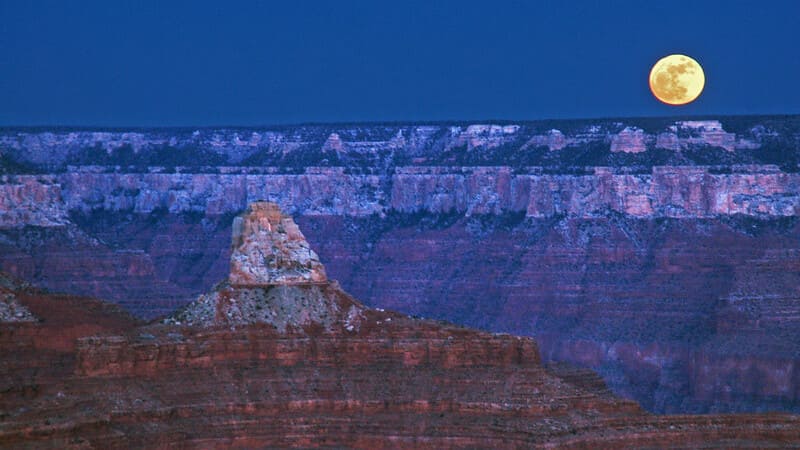
What Makes Grand Canyon a Great Stargazing Site?
The Grand Canyon, celebrated as both a natural wonder and a haven for stargazers, possesses unique attributes. Its seclusion from urban centers ensures pristine, dark skies for celestial enthusiasts. The elevation, spanning 2,000 to 8,000 feet, minimizes atmospheric interference, enhancing star and planet clarity. This arid locale guarantees extended, cloud-free nights due to minimal humidity.
Recognized as an International Dark Sky Park since 2019, the Grand Canyon National Park actively preserves its nocturnal splendor. Employing shielded lighting and educational outreach, it combats light pollution, creating an ideal setting for stargazing.
I would highly recommend the Grand Canyon National Park in Arizona. It is designated as an International Dark Sky Park, which means it offers excellent opportunities for stargazing due to minimal light pollution.
The vast, remote landscape of the Grand Canyon provides stunning views of the night sky, including the Milky Way and many constellations. It often hosts special astronomy programs and events to enhance the stargazing experience, making it a top destination for both amateur and experienced astronomers looking to enjoy the beauty of the cosmos.

By Ann Young
CEO, Fix The Photo
What to Expect from Grand Canyon’s Night Skies
Grand Canyon stargazing reveals a captivating celestial spectacle shaped by seasonal changes, lunar phases, and atmospheric conditions.
Notable features include:
- The Milky Way, our galaxy, spans the sky, showcasing its core, bulge, and arms.
- Prominent planets like Mercury, Venus, Mars, Jupiter, Saturn, and occasionally Uranus and Neptune trace the ecliptic and form captivating configurations.
- The moon transitioning through crescent to full phases and sporadically offering eclipses.
- Rich in mythology, constellations form distinct patterns when high in the sky, away from light pollution.
- Meteor showers like the Perseids, Leonids, and Geminids deliver mesmerizing displays, most vivid during moonless nights.
The Grand Canyon’s high elevation and dry climate further enhance the stargazing experience.
Exploring the Grand Canyon’s Natural Lightscape
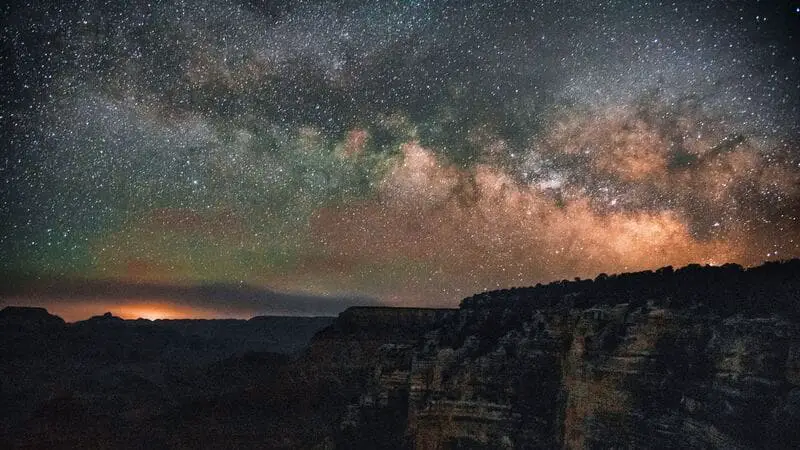
Understanding the Concept of Natural Lightscape
A “natural lightscape” signifies an unspoiled sky untouched by artificial illumination. Beyond its aesthetic appeal, it holds ecological significance by preserving the natural day-night rhythms crucial for countless organisms, including humans. It enables a profound connection to cultural heritage and our cosmic origins.
In 2001, John E. Bortle introduced the Bortle Scale, a 9-class system distinguishing pristine Class 1 night skies from heavily light-polluted Class 9 urban areas. Across the United States, light pollution has obscured the once-inspiring night sky, reducing it to fragmented constellations and sparse star visibility.
Grand Canyon National Park stands as one of the last Class 1 night sky locations in America, offering a rare glimpse into the skies of our ancestors. It’s an opportunity for astronomical exploration, artistic appreciation, and a deep connection to the beauty of nature.
Impacts of Light Pollution on Natural Nightscapes
Light pollution from streetlights, buildings, and vehicles disrupts natural darkness.
Light Pollution harms nightscapes through:
- Skyglow: Scattered artificial light brightens skies, impeding celestial visibility and natural rhythms.
- Glare: Excessive brightness causes discomfort, vision issues, and accidents.
- Light trespass: Unwanted illumination invades privacy, disrupts sleep, and wastes energy.
- Clutter: Confusing, excessive light clusters disrupt aesthetics and navigation.
This global issue affects health, wildlife, ecosystems, climate, and culture. Over 80% of the world lives under light-polluted skies, impacting melatonin in 99% of U.S. and European populations.
Solutions encompass shielded, energy-efficient lighting, timers, motion sensors, and public education to restore dark skies and their myriad benefits, including mitigating climate and cultural impacts.
FREE STARGAZING CHECKLIST
My 5-page Stargazing Checklist will enhance your astronomical observations.
Follow this free checklist to navigate the night sky with confidence, clarity, and a sense of preparedness for a rewarding stargazing experience.

Preparations for Stargazing at the Grand Canyon
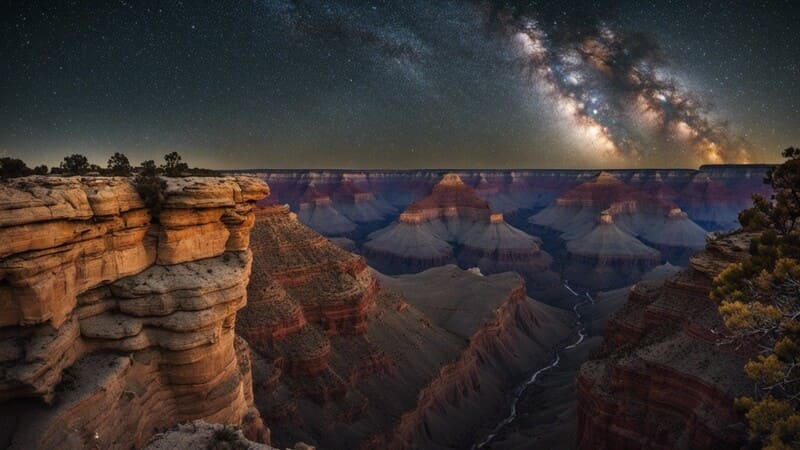
Weather Conditions and Best Time for Stargazing
Weather at the Grand Canyon varies by season, time, and location, with two distinct climate zones: the South Rim, warmer and open year-round, and the North Rim, closed from mid-October to mid-May due to snow.
Prime stargazing conditions entail clear skies, low humidity, moonless nights, and calm winds. Typically, this aligns with winter months (December to February), though they bring colder temperatures and potential snow or fog. Always check forecasts before planning.
Conversely, the summer months (June to August) bring hot, humid air, short, bright nights, and often unfavorable stargazing conditions. Yet, they offer pleasant temperatures and better accessibility.
What Equipment to Bring for Stargazing
Stargazing at the Grand Canyon necessitates equipment selection based on experience, interest, budget, and luggage capacity.
Consider these equipment options:
- Naked Eyes: The simplest approach, offering views of stars, planets, constellations, meteors, satellites, and the Milky Way. Limited in detail and color perception.
- Binoculars: These are portable and budget-friendly, enhancing views of celestial objects, including some nebulae and galaxies.
- Telescopes: The most advanced option, providing detailed views of stars, planets, constellations, meteors, satellites, nebulae, and galaxies. It requires expertise but offers richer details and colors.
Supplement your stargazing experience with essential accessories:
- Red Flashlight: Preserves night vision, aiding the visibility of faint objects.
- Star Map or App: Helps identify and locate celestial objects.
- Warm Clothes: These are essential for colder nights and include layers, hats, gloves, scarves, and boots.
- Blanket or Sleeping Bag: Adds comfort while lying on the ground or bench.
- Snacks and Drinks: Maintain energy and hydration with easily transportable options like granola bars, nuts, dried fruits, and non-alcoholic beverages.
Unique Features to Watch For
Stargazing at the Grand Canyon offers distinct advantages:
- Canyon Walls: The towering cliffs of the Grand Canyon form a natural amphitheater, framing the sky and blocking out the horizon. They reflect starlight, adding subtle ambiance.
- Colorado River: Flowing through the canyon’s depths, it acts as a natural mirror, reflecting starlight and creating a sparkling effect. The gentle sound of the river enhances relaxation.
- Wildlife: The Grand Canyon’s diverse nature provides a natural soundtrack to your stargazing. Nighttime may bring the sounds of owls hooting, coyotes howling, bats squeaking, or crickets chirping, enhancing your experience.
Grand Canyon National Park’s Dark Sky Program
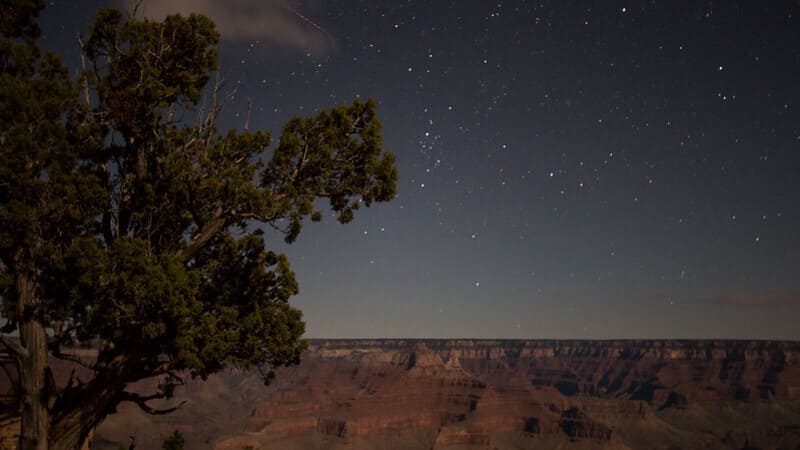
Functions and Importance of the Dark Sky Program
The Dark Sky Program, a collaboration between the Grand Canyon National Park and the International Dark Sky Association (IDA), serves three essential functions:
- Evaluation: This facet assesses the park’s night skies, measures light pollution levels, identifies artificial light sources, and gauges their impact on the environment and visitors.
- Education: The program educates park staff, visitors, and partners on the significance of preserving dark skies, the causes and consequences of light pollution, and strategies to mitigate it. It actively engages in outreach activities, including star parties, night hikes, and dark sky festivals.
- Improvement: To enhance the park’s night skies, the program enforces dark sky-friendly lighting policies, upgrades existing fixtures with efficient alternatives, monitors and reports project progress, and seeks or maintains the IDA’s dark sky park certification.
The Dark Sky Program is crucial in preserving the Grand Canyon National Park’s natural and cultural heritage, enriching visitor experiences, safeguarding wildlife and ecosystems, conserving energy and finances, and advancing its scientific and educational objectives.
Activities and Events within the Program
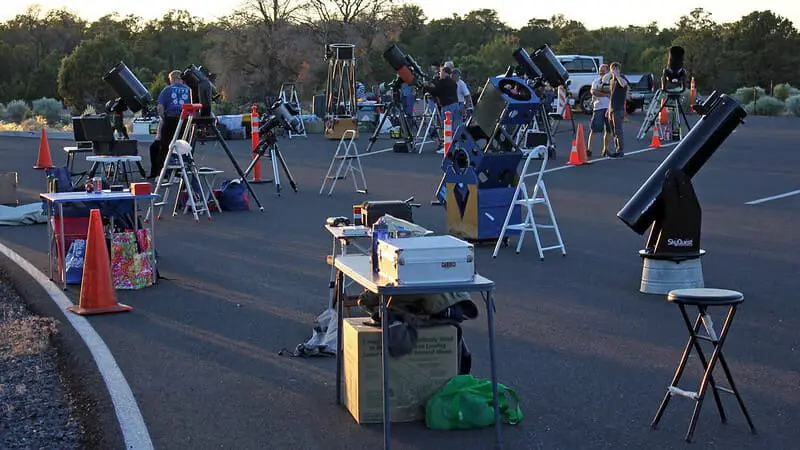
The Dark Sky Program at the Grand Canyon offers various engaging activities and events designed for visitors to appreciate and explore the park’s celestial wonders.
Activities and Events:
- Star Parties: These gatherings, led by amateur and professional astronomers, provide insight and enthusiasm for astronomy. Held year-round at prime sky-viewing spots, they furnish telescopes, binoculars, maps, red flashlights, and equipment. Summer months are ideal for catching the Milky Way.
- Night Hikes: Guided night hikes, requiring reservations, explore the park’s trails and features. Led by park rangers or volunteers, they delve into the Grand Canyon’s natural history, geology, ecology, and astronomy. Night hikes offer glimpses of nocturnal wildlife like bats, owls, and coyotes.
- Astronomy Talks: These presentations cover a wide spectrum of astronomy topics, including constellations, planets, moon phases, eclipses, and meteor showers. They are held at the Grand Canyon Visitor Center or amphitheaters and utilize slideshows, videos, models, or demonstrations. Skilled park rangers or guest speakers deliver the talks, providing deeper insights into the art and science of stargazing.
- Dark Sky Festivals: These special multi-day events celebrate the Grand Canyon’s dark skies and raise awareness about light pollution. Dark sky festivals feature a diverse range of activities, including star parties, night hikes, astronomy talks, workshops, exhibits, concerts, films, and more. Organized by the park in collaboration with partners and organizations, they offer an enjoyable way to connect with the Dark Sky community.
These activities underscore the Dark Sky Program’s commitment to educating and entertaining visitors while highlighting the importance of preserving the park’s pristine nightscapes.
Stargazing Tips for the Grand Canyon
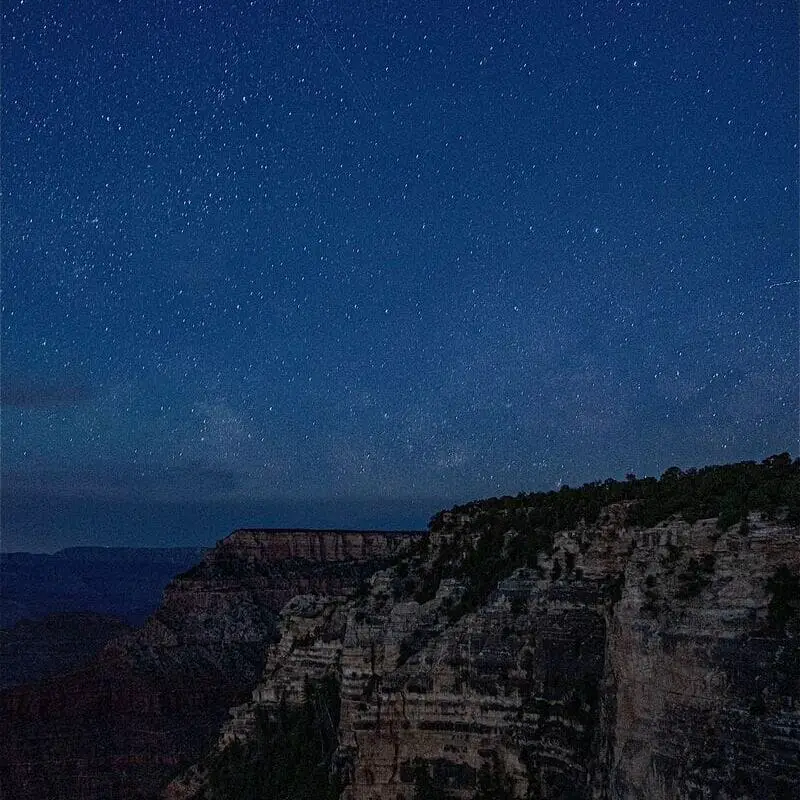
Choosing the Best Stargazing Spot in the Park
The Grand Canyon National Park has many stargazing spots that offer different views and experiences of the night sky. Some of these spots are:
Lipan Point
Lipan Point is a viewpoint on the Grand Canyon South Rim that overlooks the Colorado River and several buttes and temples. It is one of the best spots to see the Milky Way rising over the canyon walls. It is also one of the darkest spots on the South Rim.
Mather Point
Mather Point is a viewpoint on the South Rim that offers a panoramic view of the canyon. It is one of the best spots to see the sunset and twilight colors over the canyon. It is also one of the most accessible spots on the South Rim.
Yavapai Point
Yavapai Point is a viewpoint on the South Rim with a geological museum and an observatory. It is one of the best spots to see the moonrise over the canyon. It is also one of the most educational spots on the South Rim.
Bright Angel Point
Bright Angel Point is a viewpoint on the North Rim with a short trail leading to a narrow peninsula. It is one of the best spots to see the canyon from different angles and perspectives. It is also one of the most scenic spots on the North Rim.
Point Imperial
Point Imperial is a viewpoint on the North Rim, the highest point in the park at 8,803 feet. It is one of the best spots to see the sunrise and the changing colors of the canyon. It is also one of the coolest spots on the North Rim.
When choosing a stargazing spot in the park, you should consider several factors, such as:
- Visibility: You should choose a spot with a clear and unobstructed sky view, preferably with a low horizon and a wide field of view. It would be best if you also avoided sites close to light pollution sources, such as buildings, cars, or campfires.
- Accessibility: You should choose a spot that is easy to reach and safe to stay at night. Before heading to your site, you should also check the park’s operating hours, road conditions, and entrance fees. You should also follow the park’s rules and regulations, such as staying on designated trails and areas, respecting wildlife and other visitors, and leaving no trace.
- Comfort: You should choose a comfortable and enjoyable spot for you and your companions. You should also bring some equipment and supplies to make your stargazing experience more pleasant, such as warm clothes, blankets, snacks, drinks, etc.
Smart Usage of Telescopes and Binoculars
For an enriching stargazing experience at the Grand Canyon, it’s essential to employ telescopes and binoculars effectively.
Here are expert tips to maximize their utility:
- Device Selection: Begin by choosing the suitable stargazing device that aligns with your needs and preferences. Telescopes excel in revealing intricate celestial details and colors, but they come with higher costs and complexities. On the other hand, binoculars are ideal for observing a broader expanse of stars and constellations, although they may lack power and stability of telescopes. When selecting, evaluate factors like size, weight, magnification, aperture, focal length, mount, eyepiece, and available accessories.
- Proper Setup: Ensure your device is situated on a stable and level surface, far from potential vibration or wind disturbances sources. Precisely align your device with the North Star or a prominent landmark to aid in locating your celestial target. Optimize your device’s image quality by adjusting focus, zoom, and brightness settings to achieve the best results.
- Wise Usage: Enhance your stargazing venture by employing your device thoughtfully:
- Initiate with low magnification and a wide field of view to scan the sky, making locating your desired celestial object easier.
- Gradually increase magnification and narrow the field of view to explore intricate details and vibrant colors.
- Move your device smoothly and steadily to track objects as they traverse the night sky.
- To prevent eye fatigue, periodically take breaks from observing through your device, allowing you to relish the entire celestial panorama.
Tips for Night Sky Photography
For stunning Grand Canyon night sky photography, follow these tips.
Camera Selection: To capture the Grand Canyon’s night skies, choose a camera with manual settings and the ability to shoot in RAW format. Options range from DSLR and mirrorless cameras to point-and-shoot or smartphone cameras if you can adjust their settings.
Lens Choice: Opt for a wide-angle lens with a fast aperture. A focal length of 14-35mm and an aperture of f/2.8 or lower is recommended to capture more of the expansive sky and allow ample light into your camera.
Tripod Stability: Select a sturdy tripod with a ball head or pan-tilt head. This ensures your camera remains stable during long exposures, preventing any unwanted shake or blur in your photos.
Settings Optimization: Fine-tune your camera settings for night sky photography:
- ISO: Balance ISO between 800 and 3200 to capture sufficient light while minimizing noise.
- Aperture: Adjust aperture within the range of f/2.8-f/5.6 to optimize light intake and depth of field.
- Shutter Speed: Keep shutter speed in the 10-30-second range to capture detail without excessive motion blur or star trails.
- White Balance: Match white balance to the night sky’s natural color temperature (3000-5000 K).
- Focus: Use manual focus instead of autofocus for sharper results, and check focus with live view or zoom features.
Mood and Atmosphere: Consider the mood and atmosphere you want to convey in your photos, allowing for creative expression in your night sky photography.
Exploring the 2025 Star Party at the Grand Canyon

Experiences from Previous Star Parties
The Grand Canyon Star Party, held annually during the new moon phase in June, celebrates the park’s dark skies. Lasting eight nights, it draws thousands of visitors and astronomers worldwide.
Highlights include public telescope viewing, volunteer astronomers showcasing celestial wonders, and astronomy presentations at visitor centers and amphitheaters.
Kids enjoy astronomy-themed activities in campgrounds and picnic areas, while astronomy exhibits provided by park partners and organizations offer informative displays.
Special events, such as concerts and contests, add excitement. This event educates and fosters a sense of community among those fascinated by the night sky.
Highlights of the 2024 Star Party
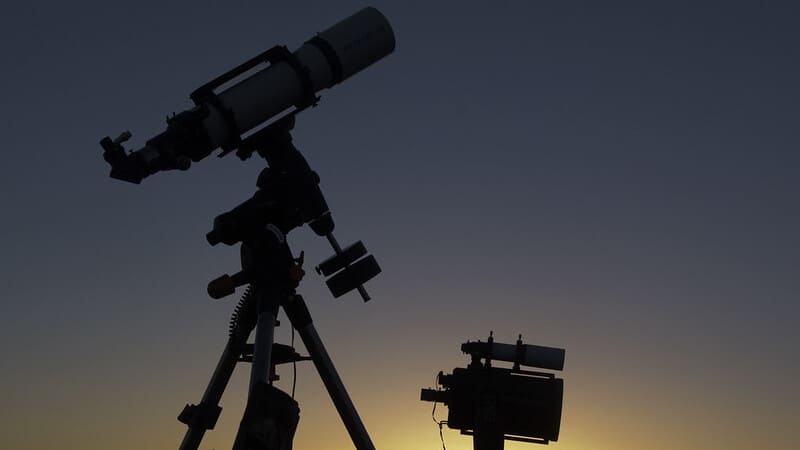
The 2024 Grand Canyon Star Party was an exceptional gathering for several compelling reasons.
The event witnessed a rare and mesmerizing total solar eclipse on April 8, 2024, visible from North America, including Arizona, with the Grand Canyon offering an unparalleled vantage point.
This marked the star party’s 30th anniversary, celebrating its journey from a small amateur astronomers’ gathering to a global attraction. New attractions included the Dark Sky Discovery Center, boasting an observatory, planetarium, exhibition hall, library, gift shop, and the exciting Night Sky Train from Williams to the South Rim.
A unique Dark Sky Campground at Point Imperial catered to stargazers, with minimal light and noise for an immersive experience.
Did you miss this unique opportunity to witness nature’s wonders and humanity’s cosmic exploration against the backdrop of the Grand Canyon?
Navigating Your Way to the Grand Canyon National Park
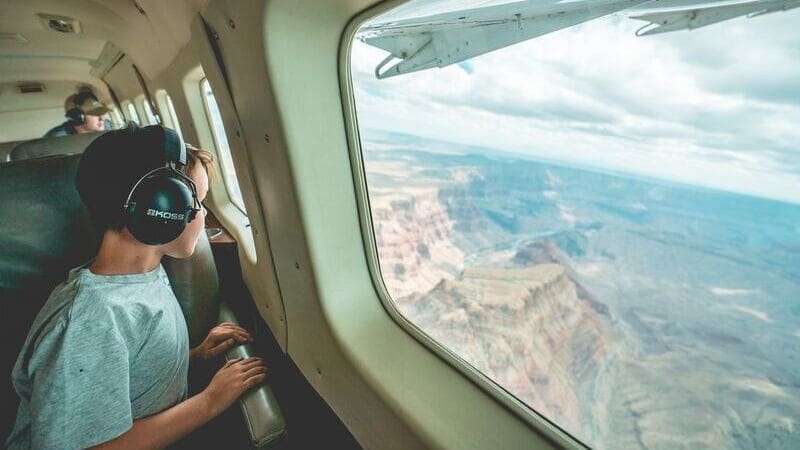
Best Routes and Transportation Modes to Get There
Reaching the Grand Canyon National Park is considering your preferences, budget, and starting point. Options abound:
- By Car: The most flexible choice, driving, offers control over your journey. Use your vehicle, rent one, or explore rideshare services. Maps, GPS, road signs, and visitor guides aid navigation. Check road conditions for potential disruptions.
- By Train: Opt for a scenic ride on the Amtrak Southwest Chief train, connecting Chicago or Los Angeles to Flagstaff or Williams. Transfer to a shuttle bus or taxi to reach the park. Alternatively, enjoy a vintage experience on the Grand Canyon Railway from Williams to the South Rim.
- By Bus: Affordable and eco-friendly, Greyhound buses connect major cities to Flagstaff. Transfer to a shuttle bus or taxi for the final leg. Tour buses from Las Vegas or Phoenix offer guided tours with stops and activities at the South or West Rim.
- By Plane: Flying is ideal for speed and comfort. Major airports like Phoenix Sky Harbor International, Las Vegas McCarran International, or Flagstaff Pulliam are convenient. Smaller airports offer helicopter or airplane tours for a scenic arrival.
Parking and Access Points
Within the Grand Canyon National Park, access is made convenient through various parking lots and entry points:
- South Entrance Station: Located on Highway 64 near Tusayan, open year-round, this primary entry serves visitors from Phoenix, Flagstaff, Williams, or Las Vegas. Its large parking area accommodates additional amenities, including cars, RVs, buses, and motorcycles.
- North Entrance Station: Found on Highway 67 near Jacob Lake, open seasonally, this primary access is used by visitors from Utah, Colorado, Nevada, or California. It offers a smaller parking area and similar amenities.
- East Entrance Station: Situated on Highway 89 near Cameron, this entrance is open year-round and caters to visitors from Page, Lake Powell, or Monument Valley. It has a compact parking lot and amenities.
Additionally, scenic routes like Desert View Drive, tracing the East Rim, and Hermit Road, along the West Rim, offer picturesque vistas, access to the Colorado River, and points of interest like the Desert View Watchtower, Tusayan Museum and Ruin, Grandview Point, Moran Point, Trailview Overlook, Powell Point, Hopi Point, and Pima Point.
Accommodations Near the Grand Canyon National Park

Camping Options in and Around the Park
Camping provides an immersive Grand Canyon National Park experience with various options:
- Mather Campground: On the South Rim, open year-round, with 327 sites for tents, trailers, and RVs up to 30 feet. Amenities include restrooms, showers, laundry, dump stations, fire pits, and picnic tables. Shuttle buses, bike rentals, and dining are accessible. Reservations and fees are required.
- North Rim Campground: Open mid-May to mid-October on the North Rim, offering 90 sites for tents, trailers, and RVs up to 40 feet. Amenities comprise restrooms, showers, laundry, dump stations, fire pits, and picnic tables. Accessible to shuttle buses, bike rentals, and dining. Reservations and fees apply.
- Desert View Campground: Found on the East Rim, open from mid-April to mid-October with 50 tent-only sites. Facilities include restrooms, water spigots, fire pits, and picnic tables. Operates on a first-come, first-served basis.
- Trailer Village: Located on the South Rim, open year-round, with 80 sites for RVs up to 50 feet. Full hookups, cable TV, restrooms, showers, laundry, and dump stations are provided. Access to shuttle buses, bike rentals, and dining. Reservations and fees are required.
- Grand Canyon Camper Village: Outside the park in Tusayan, open mid-March to mid-November, offering 124 sites for tents, trailers, and RVs up to 45 feet. Full hookups, cable TV, restrooms, showers, laundry, dump stations, fire pits, and picnic tables are available. Accessible to shuttle buses, grocery stores, restaurants, and more. Reservations and fees apply.
- Ten-X Campground: Located 4 miles south of Tusayan, open mid-May to mid-September, with 70 tent-only sites. Facilities include restrooms, water spigots, fire pits, and picnic tables. Access to hiking trails and wildlife viewing opportunities. Operates on a first-come, first-served basis.
Hotel Recommendations for Convenience and Comfort
For a hotel stay near the Grand Canyon National Park, consider these options:
- El Tovar Hotel: Located on the South Rim near Grand Canyon Village, this historic gem, built in 1905, boasts 78 rooms and suites with diverse amenities. Its rich history includes famous guests like Theodore Roosevelt and Albert Einstein. Reservations and fees are required.
- Bright Angel Lodge: On the South Rim near Grand Canyon Village, this charming lodge, dating back to 1935, offers 90 rooms and cabins with varying amenities, preserving its rustic character. Reservations and fees are necessary.
- Grand Canyon Lodge: Perched on the North Rim near Bright Angel Point, this classic hotel, established in 1928, presents 217 rooms and cabins with private bathrooms and captivating canyon views. Reservations and fees apply.
- Yavapai Lodge: Found on the South Rim near Market Plaza, this modern hotel, built in 1960 and renovated in 2018, provides 358 rooms, a restaurant, a tavern, and more. Reservations and fees are required.
- Best Western Premier Grand Canyon Squire Inn: In Tusayan, this luxurious hotel, upgraded in 2016, boasts 318 rooms and suites with extensive amenities, including a pool, hot tub, and fitness center. Reservations and fees are necessary.
- The Grand Hotel: Located in Tusayan, this cozy hotel, remodeled in 2016, offers 121 rooms and various amenities. Reservations and fees are required.
Daytime Activities in Grand Canyon National Park
Day Hiking Options and Routes
Day hiking in Grand Canyon National Park is a rewarding adventure with several options:
- Rim Trail: This mostly flat and paved trail stretches about 13 miles along the South Rim, offering breathtaking views of the canyon and river. Explore sections quickly, with shuttle buses or bikes for easy access.
- Bright Angel Trail: Descend 4,380 feet from the South Rim on this popular 9.5-mile trail, encountering incredible vistas and attractions like Indian Garden and Phantom Ranch.
- South Kaibab Trail: With spectacular views, this 7-mile trail descends 4,860 feet from the South Rim, passing Ooh Aah Point and Skeleton Point.
- North Kaibab Trail: For a challenging hike, tackle this 14-mile trail descending 5,760 feet from the North Rim. Enjoy diverse views and visit attractions like Roaring Springs and Ribbon Falls.
- Rim-to-Rim Trail: This epic 24-mile trail connects the South Rim and North Rim, offering unparalleled vistas and passing landmarks like Phantom Ranch. Be prepared for strenuous terrain and extreme temperatures.
Other Must-Do Activities in Grand Canyon National Park
In Grand Canyon National Park, there’s more than just hiking to elevate your adventure:
- Rafting: Embark on a thrilling journey down the Colorado River, witnessing the canyon’s geology and wildlife. Choose from motorized, oar-powered, or paddle-powered rafts on half-day, full-day, or multi-day trips.
- Mule Riding: Enjoy a leisurely ride on a mule or donkey along the park’s trails, immersing yourself in the canyon’s flora, fauna, and history. Options include rim rides, inner canyon rides, and overnight rides.
- Biking: Explore the park’s roads and trails on a bike, from short loops to long routes, discovering hidden gems and unique viewpoints.
- Helicopter or Airplane Tours: Soar above the canyon’s grandeur and beauty on a helicopter or airplane tour, offering panoramic views and access to otherwise hidden features. Select from various aircraft and tour durations to suit your preferences.
Frequently Asked Questions about Stargazing in Grand Canyon National Park

Information on Park’s Nighttime Guidelines
Grand Canyon National Park promotes responsible nighttime practices to safeguard its natural nightscapes:
- Use Red Lights: Opt for red lights, like flashlights or lanterns, instead of white ones for stargazing and walking at night. Red lights preserve night vision, minimize disturbance to other stargazers, and protect light-sensitive wildlife.
- Turn Off Unnecessary Lights: Avoid using car, campfires, or tent lights that aren’t essential for safety or comfort. Unneeded lights contribute to light pollution, diminish the night sky’s visibility, and waste resources.
- Respect Quiet Hours: Maintain a serene atmosphere during quiet hours from 10 p.m. to 6 a.m. by refraining from loud noises or music that might disrupt fellow visitors and wildlife. Enhance your stargazing experience and sleep quality through this consideration.
Schedules and Visibility of Celestial Events in 2024
Celestial events are natural phenomena in the sky, such as eclipses, meteor showers, comets, etc. They are often spectacular and beautiful, especially in dark and clear skies. The Grand Canyon National Park is ideal for observing celestial events, as it has low light pollution and high elevation.
Here are some of the celestial events that happened in 2024:
- Total solar eclipse: A total solar eclipse is a rare and spectacular phenomenon that occurs when the moon passes between the sun and the Earth, blocking out the sun’s light completely for a few minutes. The total solar eclipse occurred on April 8, 2024, and was visible from parts of North America, including Arizona. The Grand Canyon will be one of the best places to witness this event, as it will offer a clear and unobstructed view of the sky and a dramatic contrast between the darkened sun and the colorful canyon.
- Perseid meteor shower: The Perseid meteor shower is an annual and popular meteor shower that occurs when the Earth passes through the debris trail of Comet Swift-Tuttle. The Perseid meteor shower produces bright and fast meteors that appear to radiate from the constellation Perseus. The Perseid meteor shower peaks around August 12-13 every year, and it can produce up to 100 meteors per hour. The Grand Canyon is a great place to watch the Perseid meteor shower, as it has dark and clear skies that allow you to see more meteors.
- Comet Bernardinelli-Bernstein: Comet Bernardinelli-Bernstein is a newly discovered and potentially spectacular comet that is expected to make its closest approach to the sun in 2031. However, depending on its brightness and activity, it may be visible to the naked eye as early as 2024. Comet Bernardinelli-Bernstein is estimated to be about 1000 times larger than a typical comet and may have a long and bright tail. The Grand Canyon is a beautiful place to see Comet Bernardinelli-Bernstein, as it has low light pollution and high elevation that enhance your view of the comet.
Summary: Stargazing at Grand Canyon
Thank you for reading my article on Grand Canyon Stargazing.
The Grand Canyon National Park is a magnificent place that offers many opportunities and activities for stargazing enthusiasts. You can experience its natural nightscapes, dark sky program, star party, daytime activities, and celestial events in 2025. You can also plan your trip by choosing your best route and transportation mode, parking and access point, accommodation option, hiking option and route, and other must-do activities. Doing so can make your stargazing trip to the Grand Canyon National Park more enjoyable and memorable.
Happy Stargazing!
Additional articles from my Dark Sky Parks series you may enjoy:
- Acadia National Park
- Anza-Borrego Desert State Park
- Arches National Park
- Big Bend National Park
- Bryce Canyon National Park
- Capulin Volcano National Monument
- Cherry Springs State Park
- Copper Breaks State Park
- Cosmic Campground Dark Sky Sanctuary
- Death Valley National Park
- Enchanted Rock State Natural Area
- Great Basin National Park
- Haleakala National Park
- Joshua Tree National Park
- Massacre Rim Dark Sky Sanctuary
- Olympic National Park
- Oracle State Park
- Red Rock Canyon State Park
- Rocky Mountain National Park
- Tonopah Stargazing Park
- Yellowstone National Park
- Zion National Park





